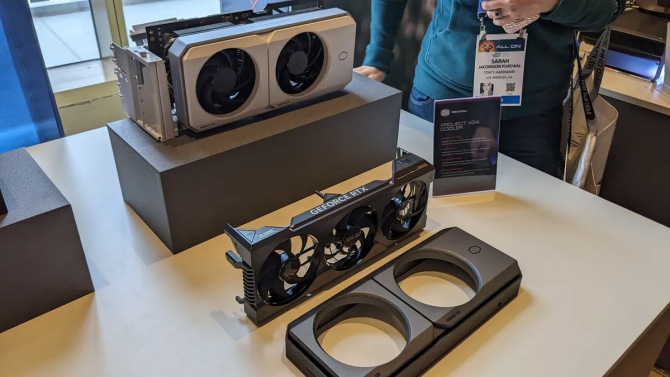If you are bold enough to give it a try, the business claims that it can reduce noise and temperature.
At this year’s Consumer Electronics Show (CES), Cooler Master appears to be making an effort to bring back a long-lost art form: the aftermarket GPU cooler. In order to replace the three-fan device that is now utilised on many graphics processing units (GPUs) manufactured by both AMD and Nvidia, the business is showcasing a prototype cooler that has two fans at the show. In many instances, three fans are not required because even midrange graphics processing units (GPUs) are now delivering this cooling solution. This appears to be the logic behind Cooler Master’s decision.
The piece of equipment that Cooler Master brought to the expo was shot by Tom’s Hardware, and it is the same length as a standard cooling shroud that has three fans. On the other hand, it only has two fans and appears to be considerably thicker, which means that you would be exchanging three smaller fans that spin at high RPM for two larger fans that move at a slower speed. As far as that swap is concerned, the math is correct on our end; but, because there are no side-by-side benchmarks, it is difficult to evaluate how visible the benefits of the configuration would be in real life. Mobius fans, which Cooler Master claims are optimised for acoustics and airflow across a variety of use cases, will be utilised by Cooler Master for the cooler that has not yet been named.
There are a number of reasons why this cooler is probably not going to work, despite the fact that every PC enthusiast would appreciate less noise and lower temperatures in their computer. The fact that GPU coolers are not designed to be easily disassembled by the end user is the most significant obstacle, as doing so can render your warranty null and void. When it comes to a graphics processing unit (GPU), the majority of individuals who spend a significant amount of money on it will be reluctant to do open heart surgery on it, particularly if the end result is that it runs a few degrees cooler. An additional obstacle is that, in comparison to cards of earlier generations, those of today often operate at a lower temperature and with less noise. Because to advancements in efficiency, the days of a screaming graphics processing unit (GPU) are now a thing of the past. Also, a GPU shroud that is silver or white might not go well with the aesthetics of your personal computer.
When both Nvidia and AMD marketed reference-design graphics processing units (GPUs) with blower-style coolers that utilised a single, high-speed fan, aftermarket GPU coolers were a thing. Aftermarket GPU coolers were a thing back then. Despite the fact that this design was excellent at removing hot air from the chassis, they were extremely loud. Because of the unwelcome noise, some people decided to replace them with aftermarket coolers that were similar to those that were available on more expensive graphics processing units (GPUs) that had dual and triple fans that were positioned on top of a lengthy heatsink. Those are products from a bygone period, however, as the firms who manufactured them, such as Arctic, have now reported that they are no longer available for purchase. As the blower-style GPU cooler is typically only seen in pre-built cards, AMD and Nvidia have begun selling reference-design graphics processing units (GPUs) that come equipped with heatsinks and fans.
Our gratitude goes out to Cooler Master for their intentions in this matter. Despite this, we are unable to fathom why anyone would be interested in purchasing one of these, if that it ever makes it to market. It is likely that firms such as Asus, Gigabyte, and MSI, which manufacture graphics processing units (GPUs), would want to include it as an additional feature on their GPUs, similar to the Noctua versions of GPUs that have been introduced in recent times. However, even that is a difficult task to accomplish because those businesses have already invested a significant amount of money in the production of their own coolers. Regardless, this is an intriguing initiative; but, we are sceptical that it will ever be able to establish a strong presence in the market, even if it ever comes to fruition.

